Frank, Frederick & Alice. "The Children of the Battle Field"
Wenderoth, Taylor & Brown American
After Unknown
Not on view
Only a small number of soldiers wore ID badges during the Civil War. One day after the Battle of Gettysburg, a Union soldier was discovered with no other form of identification except an ambrotype of three small children clutched in his hand. This carte de visite is a copy of that original portrait and was sold during the war to support the care and education of orphaned children.
On October 19, 1863, The Philadelphia Inquirer published “Whose Father Was He?” The editors requested that “all the papers in the country will draw attention to the discovery of this picture and its attendant circumstances, so that, if possible, the family of the dead hero may come into possession of it.” Newspapers and magazines throughout the North republished the article, and ultimately it was seen by Philinda Humiston, a mother of three who had not heard from her husband, Amos, since before Gettysburg. Humiston wrote to the discoverer of the photograph, a physician, who replied by mail and enclosed a carte-de-visite copy of the ambrotype, which Mrs. Humiston identified positively. From charitable gifts and the proceeds from the sale of the photographs, the National Homestead, a widows’ and orphans’ home, would open at Gettysburg in October 1866. Philinda Humiston lived there with her children for three years.
Due to rights restrictions, this image cannot be enlarged, viewed at full screen, or downloaded.
This artwork is meant to be viewed from right to left. Scroll left to view more.



